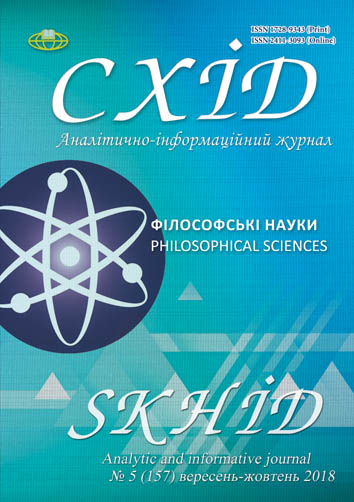Essence and appointment of art in aesthetic learning by G. Hegel
DOI:
https://doi.org/10.21847/1728-9343.2018.5(157).148366Keywords:
German classical aesthetic, G. Hegel, art, beautiful, sensual form, appearance outside, idea of ideasAbstract
The article is devoted to the analysis of the problem of essence and art appointment in aesthetic by G.V.F. Hegel. It was found out the main intentions of aesthetic searches by the German philosopher in connection were connected with the “problem of a primary source”. The aim and essence of art have been studied out in correlation to spirit philosophy and to philosophy of thinker’s history.
It is underlined the ontological principles of art as the subject of investigation. It is emphasized that in aesthetic lectures G. Hegel tried to understand the essence and nature of art beyond measures of his system (principles of which were known already to readers and visitors of his lectures, including the place of aesthetic problematic), tried to build them in a such way to remind an experimental search of general understanding on the base of historical facts and philosophical thinking. Art, for Hegel, also gives expression to spirit's understanding of itself. It differs from philosophy and religion, however, by expressing spirit's self-understanding not in pure concepts, or in the images of faith, but in and through objects that have been specifically made for this purpose by human beings. Such objects – conjured out of stone, wood, color, sound or words – render the freedom of spirit visible or audible to an audience. The attention is focused on the point that the main purpose of art is not the imitation of nature or embellishment of the world but it is a bridge between pure thought and material existence, the way where spirit itself appears outside, this is the sensual form of freedom, self expression and self cognition, inheritance of absolute spirit.References
Hegel, G. 1970. The science of logic. In 3 vol. Volume 1. Moscow (rus).
Hegel, G. 1977. Encyclopedia of Philosophical Sciences in 3 vol. Volume 3. Philosophy of the spirit. Moscow (rus).
Koreneva, N. 2013. The thesis about the "end of art" in Hegel's aesthetics and his interpretation in modern philosophy. Dis. ... cand. philos. sciences (09.00.05 - history of philosophy). Moscow (rus).
Adorno, T. 1977. Aesthetic Theory, trans. R. Hullot-Kentor. London: Athlone Press. (eng).
Gaiger, J. 2006. Catching up with history. Hegel and abstract painting. In the Hegel: New directions. McGill-Queen's University Press. Acumen, Quebec. 159-176. (eng).
Gethmann-Siefert, A. 1995. Introduction to aesthetics. Munich: Finch. (ger).
Gethmann-Siefert, A. 2005. Introduction to Hegel's Aesthetics. Wilhelm Fink, Munich. (ger).
Hammermeister, K. 2002. The German Aesthetic Tradition. Cambridge: Cambridge University Press. (eng).
Hegel, G. 1842. Lectures on Aesthetics. Berlin: Duncker and Humblot. (ger).
Hegel, G. 1995. Lectures on aesthetics. Frankfurt am Main, Peter Lang. (ger).
Hegel, G. 1998. Lectures on the philosophy of art. Berlin 1823. Reprinted by H. G. Hotho. Edited by Annemarie Gethmann-Siefert. Lectures, Volume 2. Felix Meiner Verlag, Hamburg. (ger).
Hegel, G. 2003. Lectures on the Philosophy of Art, ed. by A. Gethmann-Siefert. Hamburg: Felix Meiner Verlag. (ger).
Hegel, G. 2004. Philosophy of Art. Lecture of 1826. Ed. A. Gethmann-Siefert, J.-I. Kwon and K. Berr. Surkamp, Frankfurt am Mein, 2004. (ger).
Lectures on the Philosophy of Art. 2014. The Hotho Transcript of the 1823 Berlin Lectures, trans. R.F. Brown. Oxford: Clarendon Press. (eng).
Downloads
Published
How to Cite
Issue
Section
License
Copyright (c) 2018 Igor Pecheranskiy

This work is licensed under a Creative Commons Attribution-NonCommercial-NoDerivatives 4.0 International License.
1. Authors bear responsibility for the accuracy of facts, quotations, numbers and names used.
2. Manuscripts are not sent back.
3. The publisher does not always agree with the authors' opinion.
4. The authors reserve the right to authorship of the work and pass the first publication right of this work to the journal under the terms of a Creative Commons Attribution Non-Commercial License, which allows others to freely distribute the published research with the obligatory reference to the authors of the original work and the first publication of the work in this journal.
5. The authors have the right to conclude separate supplement agreements that relate to non-exclusive work distribution in the form in which it has been published by the journal (for example, to upload the work to the online storage of the journal or publish it as part of a monograph), provided that the reference to the first publication of the work in this journal is included.

